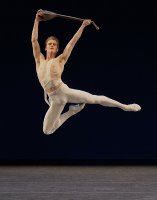by Edna Landau
To ask a question, please write Ask Edna.
 From time to time, I receive questions from parents who want to help guide their children along a not very clearly defined career path, or who simply want to understand how things work. Since Mother’s Day was celebrated just a few days ago, I thought it would be fitting to share an important question from a caring mom.
From time to time, I receive questions from parents who want to help guide their children along a not very clearly defined career path, or who simply want to understand how things work. Since Mother’s Day was celebrated just a few days ago, I thought it would be fitting to share an important question from a caring mom.
Dear Edna:
I am writing from the position of a supportive mother of a daughter in her early teens who has passionate aspirations to be a world-class violinist. She studies with a prominent teacher and has already had opportunities to perform professionally, receiving very positive feedback. I have been wary of my position, never wanting to become the stereotypical “stage-mom,” yet nonetheless wanting to guide her as she avails herself of good opportunities for growth. Naturally, this includes engagements that will give her greater exposure. My question is: where does one draw the line between good and bad exposure? Does the aphorism “there is no such thing as bad publicity (exposure)” ring true in the classical music world as it does in other realms of (admittedly) popular and political culture? What guidelines should we follow when presented with opportunities that may yield great exposure but would not guarantee us the liberty to have input with regard to the nature of the exposure (for example, Reality TV shows)? Thanks in advance for your feedback. I look forward to your words of wisdom. —Eager to Learn
Dear Eager to Learn:
From the way you have asked your question, I can tell that you are not only a supportive mother but also a wise and insightful one.
While it is true that opportunities for major exposure are few and far between in the classical music world, the one instance where the media comes knocking on the door is in the case of a young, prodigiously gifted and often physically attractive artist. At such a time, it is natural for a parent to be faced with very conflicting thoughts. If I say no to this, will anyone ever ask again? If I say yes, won’t the doors open wide, thereby assuring my child’s future success? In my experience, if a young musician possesses the genuine gifts that will earn him or her a major performing career, it is wise to develop these gifts out of the limelight. The media is likely to promote the artist as the latest “hot prodigy”; however, a young child or teenager, no matter how gifted, has a long career path ahead of them. They will not be young and adorable forever and once the “prodigy” label no longer applies to them, the popular media may lose interest in them and move on to the next young sensation—unless the attention afforded to them is backed up by extraordinary talent and accomplishment that is generally only achieved after years of hard work. If a news show wants to cover some significant development in the young artist’s career, there is no harm, provided the artist is properly coached and any on-air performance is carefully prepared and can be ensured to take place under acceptable conditions.
In the early years of a career, it is generally best to restrict media exposure to situations where it is not uncommon for a classical musician to perform (such as the BBC “Young Musician of the Year” telecast in the U.K., which is part of the prize), or where the conditions are maximized for a successful outcome. When violinist Hilary Hahn was fifteen and I was her manager, an opportunity presented itself for her to play the Beethoven concerto live on German television with Lorin Maazel and the Bavarian Radio Orchestra. Recognizing that this particular repertoire was usually performed by artists twice her age, her parents and I did not discourage her from accepting the offer because Maestro Maazel had mentored her in this particular piece and performed it with her on several occasions. It proved to be a wildly successful introduction for her to the European classical music world. Had she been offered the equivalent of a modern reality show at that stage, I am sure we would all have said no.
My advice to you is to surround yourself with qualified, experienced and insightful individuals who can help guide you in sorting through media opportunities that may present themselves. Your daughter’s teacher is an excellent starting point. Now that YouTube and mobile phones are part of our daily life, it is hard to exercise control over any performance once it has taken place. However, we can limit problems by having expert contractual advice from the start. You should never agree to any media offer without the counsel of an experienced manager and/or entertainment attorney. In most situations, they can help you in limiting the scope of the exposure, should you wish to do so, and in preventing unauthorized use of your daughter’s performance.
In this phase of your daughter’s career, “good exposure” is exposure that allows her to be presented favorably in a suitable context. Classical musicians often come across as odd when presented alongside pop music performers, athletes and the like. (This becomes less of a problem when the artist is already a celebrity.) In addition to the nature of exposure, you might also want to give some thought to frequency. While there may come a time when seemingly simultaneous exposure from different directions may be extremely effective in raising your daughter’s profile, that approach should be reserved for the moment when she has had ample chance to try things out, gain considerable performing experience and achieve a level of personal and artistic maturity that will help her grow from the spotlight centered on her. For now, nothing would be better than to say yes only to opportunities for healthy exposure and have her leave her growing audience hungry for more.
To ask a question, please write Ask Edna.
© Edna Landau 2011
